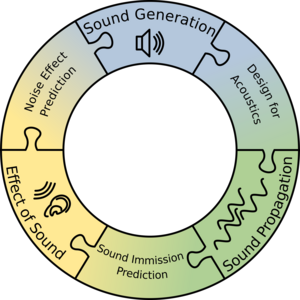Acoustics and Environmental Noise
Noise is a sound that is perceived by a person as disturbing. Across Europe, around 140 million people are exposed to harmful noise, with road (113 million), rail (22 million) and air traffic (4 million) being the main sources of noise. Around 1 million people are affected by industrial noise. In addition, high noise pollution also threatens wildlife. The research is based on the theoretical principles of noise generation at source, radiation and propagation, taking into account topography and atmosphere, such as meteorology, shielding and ground attenuation.

Physical mechanisms are fundamentally investigated in order to better understand how technical sound sources can be controlled from source to perception. This requires co-operation with other disciplines such as mechanical engineering, civil engineering and medicine. The aim is to design sound sources in such a way that only the desired sounds are emitted, while unwanted noises are attenuated.
For more detailed information, see here.
